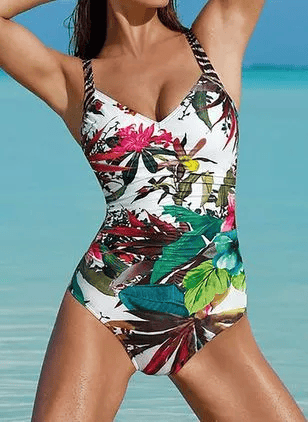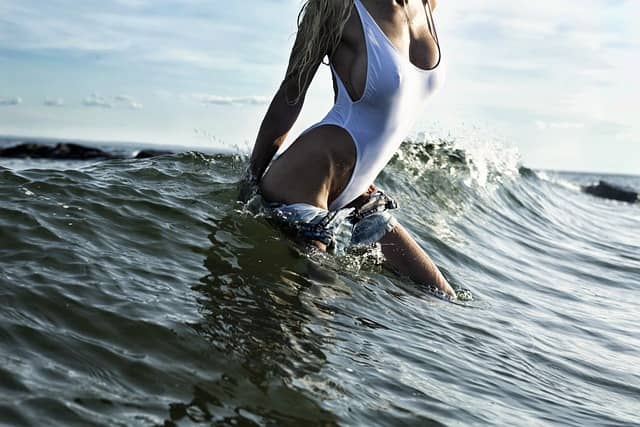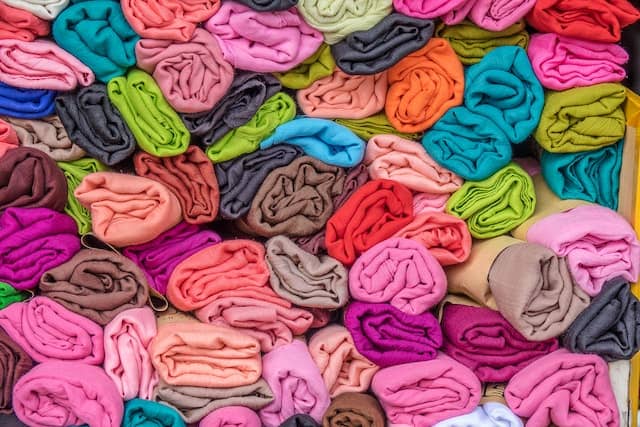The material of your swimsuit can either make or break your customers’ beach day. That’s why choosing the perfect fabric for your swimwear is crucial for comfort, performance, and style.
Swimsuits are typically made from a blend of materials, such as polyester, nylon, and elastane, which work together to provide colorfastness, chlorine resistance, and stretch.
Whether you’re a competitive swimmer or a casual beachgoer, understanding the properties of different swimsuit fabrics can help you make an informed decision.
In this article, we’ll explore the characteristics of swimsuit materials and help you find the perfect fabric for your swimwear business.
Get ready to make a splash with your newfound knowledge!
Key Takeaways
- Factors like comfort, intended use, and sustainability play crucial roles in selecting the right swimwear material.
- Swimsuits are made from blends of materials like polyester, nylon, and elastane for optimal performance.
- Each swimsuit fabric offers unique benefits, such as durability, stretch, and chlorine resistance.
Common Materials for Swimsuits
1. Nylon

Nylon is a versatile synthetic fabric that has become a staple in swimwear. Its unique properties make it an excellent choice for various swimsuit styles, offering both functionality and comfort for swimmers and beachgoers alike.
Nylon’s popularity in swimwear stems from its remarkable blend of strength and flexibility. This synthetic fiber is known for its ability to stretch and retain its shape, making it ideal for form-fitting swimsuits.
You’ll find nylon in a wide range of swimwear, from sleek one-piece suits to stylish bikinis.
One of nylon’s standout features is its impressive UPF rating, typically 50+. This means your swimsuit provides excellent protection against harmful UV rays.
Another advantage is its chlorine resistance, with some nylon blends withstanding up to 500 hours of exposure to pool chemicals.
Nylon swimsuits dry quickly, a crucial feature for comfort and practicality. This rapid-drying ability helps prevent chafing and discomfort, especially when transitioning from water to land activities.
The lightweight nature of nylon also contributes to its comfort, allowing for unrestricted movement in the water.
Pros
- Excellent stretch and shape retention
- Lightweight and comfortable
- Quick-drying properties
- High UPF rating (typically 50+)
- Strong chlorine resistance (up to 500 hours)
- Durable and long-lasting
- Soft and smooth texture
- Available in a wide range of colors and prints
Cons
- May pill or snag more easily than some other fabrics
- Can be less breathable in hot conditions
- Tends to absorb odors over time
- May lose elasticity faster with frequent use and exposure to chlorine
- Can be more expensive than some alternative swimwear materials
- Requires careful washing to maintain its properties
2. Polyester

Polyester is a popular synthetic fabric choice for swimwear due to its durability and resistance to harsh pool chemicals. This versatile material offers excellent color retention and shape maintenance, making it ideal for both competitive and recreational swimsuits.
Polyester swimwear fabric excels in chlorine resistance, withstanding up to 600 hours of exposure without significant degradation. This makes it particularly suitable for frequent swimmers and competitive athletes.
The material also boasts impressive UV protection, with many polyester swimsuits offering a UPF rating of 50+.
Fabric manufacturers like Carvico and Invista have developed specialized polyester blends for swimwear. These fabrics combine the strength of polyester with the stretch of spandex, resulting in suits that retain their shape and color even after prolonged use.
For recreational swimwear, polyester provides excellent colorfastness. Your vibrant prints and patterns will stay bright, even after exposure to sun, salt water, and chlorine.
This durability makes polyester swimsuits a cost-effective choice for beachgoers and pool enthusiasts alike.
Pros
- High chlorine resistance (up to 600 hours)
- Excellent UV protection (UPF 50+)
- Superior color retention
- Quick-drying properties
- Durable and long-lasting
- Resistant to stretching and sagging
- Affordable compared to some other swimwear fabrics
Cons
- Less breathable than natural fabrics
- Can feel less soft against the skin compared to nylon
- May pill over time with frequent use
- Not as environmentally friendly as some newer sustainable options
- Can retain odors if not properly cared for
3. Spandex (Lycra)

Spandex, also known as Lycra, is a game-changer in swimwear. This synthetic fiber offers exceptional stretch and recovery, making it a top choice for comfortable, form-fitting swimsuits that move with your body.
Spandex boasts impressive elasticity, capable of stretching up to 500% its original length without breaking. This remarkable property allows for swimsuits that offer a perfect fit and excellent freedom of movement.
You’ll find spandex in various swimwear styles, from competitive racing suits to everyday beachwear.
The material’s shape retention is exceptional, snapping back to its original form after stretching. This means your swimsuit maintains its fit even after prolonged use. Spandex typically provides a UPF rating of 50+, offering excellent sun protection for your skin.
Chlorine resistance is another key feature. High-quality spandex blends can withstand up to 200 hours of exposure to chlorinated water, which can be beneficial for regular swimmers.
The material is often combined with nylon or polyester to enhance durability and performance.
Pros
- Exceptional stretchability (up to 500%)
- Superior shape retention
- Excellent fit and comfort
- High UPF rating (50+)
- Chlorine resistant (up to 200 hours)
- Quick-drying properties
- Lightweight and breathable
- Ideal for competitive and recreational swimming
Cons
- Can be more expensive than other materials
- May degrade faster if not properly cared for
- Can be less durable than some alternatives
- Potential for pilling over time
- May not provide as much compression as some specialized fabrics
- Can be affected by heat and oils
4. Cotton

Cotton swimsuits offer a natural alternative to synthetic materials. While less common for water activities, they excel in comfort for casual beachwear and lounging.
Cotton swimwear provides a soft, breathable option for beach days. You’ll find it most often in cover-ups, board shorts, and casual swim tops. The UPF rating of cotton varies widely, from as low as 5 to over 30, depending on the weave and treatment.
Cotton’s primary drawback is its poor performance in water. It absorbs moisture quickly, becoming heavy and taking longer to dry. In chlorinated pools, cotton breaks down faster than synthetic materials.
For poolside lounging or quick dips, cotton blends can work well. Pure cotton suits are best suited for sunbathing or casual beach walks. Industry reports show that cotton makes up less than 5% of swimwear materials due to its limitations in water.
Pros
- Soft and comfortable against skin
- Highly breathable, ideal for hot days
- Natural, biodegradable material
- Affordable and widely available
- Hypoallergenic, suitable for sensitive skin
- Easy to care for and machine washable
Cons
- Absorbs water, becoming heavy when wet
- Slow to dry compared to synthetics
- Poor chlorine resistance, breaks down quickly in pools
- Tends to lose shape after repeated use
- Limited stretch, may not provide ideal fit for active swimming
- Variable sun protection, often lower than synthetic options
- Can become see-through when wet if not lined properly
5. Velvet

Velvet swimwear offers a luxurious and eye-catching option for those seeking a unique poolside look. This unexpected fabric choice brings a touch of opulence to swimsuit designs, perfect for fashion-forward individuals and special occasions.
Velvet swimsuits boast a rich, plush texture that sets them apart from traditional swimwear materials. You’ll find this fabric primarily used in designer pieces and fashion-forward swimwear, rather than performance-oriented suits.
Velvet swimwear typically features a blend of synthetic fibers to enhance durability and water resistance.
The UPF rating of velvet swimsuits can vary widely, depending on the specific fabric composition and treatment. Generally, you can expect a UPF rating between 15 and 50+.
However, velvet’s chlorine resistance is relatively low, making it more suitable for occasional use rather than frequent swimming in treated pools.
Fashion designers often incorporate velvet into one-piece swimsuits, bikini tops, and cover-ups to create a glamorous poolside or beachwear look.
The fabric’s light-absorbing properties can create a slimming effect, making it a popular choice for evening swim events or luxury resort wear.
Pros
- Luxurious appearance and soft texture
- Unique aesthetic that stands out from traditional swimwear
- Can create a slimming effect due to light-absorbing properties
- Ideal for fashion-forward designs and special occasions
- Comfortable against the skin
- Available in a wide range of colors and patterns
Cons
- Limited durability in chlorinated water
- May require special care and gentle washing
- Not ideal for athletic swimming or frequent use
- Can be more expensive than traditional swimwear fabrics
- May take longer to dry compared to synthetic performance fabrics
- Potentially less UV protection than specially treated swimwear materials
Specialized Swimwear Fabrics
1. Neoprene

Neoprene is a versatile synthetic rubber material widely used in swimwear, especially for cold water activities. It offers excellent insulation and buoyancy, making it a top choice for wetsuits and thermal swimwear.
Neoprene, originally developed by DuPont in the 1930s, is known for its exceptional thermal properties.
When used in swimwear, it traps a thin layer of water between your skin and the suit, which your body heat then warms up. This creates an insulating barrier against cold water.
Wetsuits made from neoprene can keep you warm in water temperatures as low as 50°F (10°C). The material’s thickness typically ranges from 2mm to 6mm, with thicker suits providing more insulation.
Neoprene swimwear offers impressive UV protection with a UPF rating of 50+. This means it blocks over 98% of harmful UV rays, keeping your skin safe during long hours in the sun.
The material also boasts excellent chlorine resistance, withstanding up to 200 hours of exposure before showing signs of degradation.
Pros
- Superior thermal insulation
- High buoyancy, aiding swimming and flotation
- Excellent UV protection (UPF 50+)
- Highly chlorine-resistant (up to 200 hours)
- Durable and long-lasting
- Flexible and comfortable when properly fitted
- Suitable for various water activities (surfing, diving, kayaking)
Cons
- Can be more expensive than other swimwear materials
- May feel bulky or restrictive compared to thinner fabrics
- Can be challenging to put on and take off
- Requires special care and cleaning to maintain its properties
- May cause overheating in warm water or during intense activity
- Not as quick-drying as some synthetic materials
2. PBT (Polybutylene Terephthalate)

PBT is a high-performance fabric that’s revolutionizing swimwear. It offers exceptional durability and comfort for swimmers of all levels.
PBT, or Polybutylene Terephthalate, is a game-changer in swimwear technology. This fabric boasts impressive resistance to chlorine and UV rays, making it ideal for frequent swimmers and outdoor enthusiasts.
PBT’s durability is unmatched, with a chlorine resistance of up to 800 hours. This means your swimsuit will maintain its shape and color even after countless pool sessions.
The fabric’s stretch recovery is remarkable, allowing for a snug fit that bounces back swim after swim. You’ll find PBT commonly used in competitive swimwear, where performance is crucial.
With a UPF rating of 50+, PBT offers excellent sun protection. This feature is particularly beneficial for open water swimmers and beachgoers who spend extended periods in the sun.
Many top sportswear manufacturers have embraced PBT for its superior qualities. Industry reports show a growing trend towards PBT in high-performance swimwear.
Pros
- Highly chlorine-resistant (up to 800 hours)
- Excellent UV protection (UPF 50+)
- Superior stretch and recovery
- Durable and long-lasting
- Ideal for competitive swimming
- Retains shape and color over time
- Quick-drying properties
Cons
- Can be more expensive than traditional swimwear fabrics
- May feel stiffer compared to softer materials like nylon
- Limited color options due to manufacturing process
- Requires special care instructions
- Not as widely available as other swimwear materials
3. Recycled Fabrics

Recycled fabrics are revolutionizing the swimwear industry, offering eco-conscious options without compromising on style or performance. These innovative materials are transforming plastic waste into fashionable and functional swimsuits.
The swimwear market is embracing recycled materials like REPREVE and ECONYL.
These fabrics are made from recycled plastic bottles and discarded fishing nets, reducing ocean pollution and landfill waste. Many brands now offer eco-friendly swimsuits using these materials.
Recycled fabrics boast impressive performance characteristics. They typically offer UPF 50+ sun protection, shielding your skin from harmful UV rays.
Their chlorine resistance is comparable to traditional polyester and nylon, ensuring your swimsuit maintains its shape and color even after frequent pool use.
Brands like Vitamin A are leading the way with fabrics such as EcoLux™ and EcoRib®, made from recycled nylon and plant-based fibers. These materials combine sustainability with the stretch and comfort you expect from high-quality swimwear.
Pros
- Reduces plastic waste in oceans and landfills
- Conserves energy and resources compared to virgin fabric production
- Offers excellent UV protection (UPF 50+)
- Maintains shape and color after exposure to chlorine and saltwater
- Provides comfort and stretch similar to traditional swimwear fabrics
- Supports sustainable fashion initiatives
- Available in a wide range of styles and designs
Cons
- May be more expensive than swimsuits made from conventional materials
- Limited availability compared to traditional swimwear options
- Potential concerns about microfiber shedding during washing
- Some recycled fabrics may not be as soft as virgin materials
- Can be challenging to verify the authenticity of recycled content claims
- May require special care to maintain fabric quality over time
Factors to Consider When Choosing Materials for Swimsuits

Before deciding which type of swimwear fabric to sell to your customers, there are some things to consider.
These factors will also help you choose the right private label swimwear manufacturer in case you’re launching a brand.
Here’s what you should look out for:
1. Composition
Swimsuit fabrics typically consist of blends that combine durability, stretch, and moisture-wicking properties. The most common materials include nylon, polyester, and spandex (elastane).
Nylon and polyester blends are popular due to their strength and quick-drying characteristics. These synthetic fibers often make up 80-90% of the fabric composition, with spandex accounting for the remaining 10-20%.
Spandex provides crucial elasticity, allowing your swimsuit to stretch and retain its shape. This ensures a snug, comfortable fit that moves with your body in the water.
Some high-performance swimwear incorporates specialized blends:
- Chlorine-resistant fabrics (up to 100% polyester)
- UV-protective materials
- Recycled polyester and spandex blends for eco-friendly options
The fabric weight also impacts performance and comfort. Most swimwear ranges from 180-200 grams per square meter (gsm).
Lighter fabrics (around 150 gsm) feel more like lingerie, while heavier options (200-220+ gsm) suit competitive swimming or textured designs.
When choosing your swimsuit, consider how the fabric composition affects:
- Durability: Higher nylon or polyester content increases longevity
- Comfort: More spandex provides greater flexibility
- Quick-drying: Synthetic blends dry faster than natural fibers
- UV protection: Some fabrics offer built-in sun protection
By understanding these fabric properties, you can select a swimsuit that best meets your needs for style, comfort, and performance.
2. Colorfast
When choosing swimwear, colorfastness is a crucial factor to consider. It determines how well your swimsuit maintains its vibrant hues despite exposure to chlorine, saltwater, and UV rays.
Colorfast fabrics resist fading and running, keeping your swimsuit looking fresh for longer. You’ll want to look for swimsuits with excellent colorfast properties to ensure your beachwear stays bright and attractive.
Industry standards for testing colorfastness include:
- AATCC Test Method 61: Colorfastness to Laundering
- ISO 105-E03: Colorfastness to Chlorinated Water
These tests simulate real-world conditions to evaluate how well swimwear fabrics retain their color.
When sourcing swimwear, check the label for colorfast claims. Many high-quality swimsuits use specially treated fabrics or dyes that resist fading.
You can also look for swimwear made from recycled nylon or polyester, which often have excellent colorfastness.
Remember, proper care can help maintain your swimsuit’s color. Rinse it in cold water after each use and avoid leaving it in direct sunlight when not in use.
This will help preserve the vibrant colors you love, keeping your swimwear looking great season after season.
3. Weight
The weight of swimsuit fabric plays a crucial role in comfort and performance. Most fashion swimwear fabrics range from 180-200 g/m². This weight strikes a balance between durability and lightweight feel.
Lighter fabrics, around 150 g/m², feel more like lingerie. They’re great for lounging but may not hold up well during active swimming.
Heavier fabrics, weighing 200-220 g/m² or more, are better suited for competitive swimming. These materials offer more support and durability for intense water activities.
Neoprene, used in wetsuits, is on the heavier end. It provides excellent insulation but may feel bulky for casual swimming.
Remember, fabric weight affects how quickly your suit dries. Lighter materials typically dry faster, which is handy for frequent swimmers.
Your ideal swimsuit weight depends on your activities. A lightweight suit offers freedom of movement for casual beach days. A heavier fabric provides more coverage and support for water sports.
4. Elasticity
Elasticity is crucial for your swimsuit’s performance and comfort. Spandex, also known as elastane or Lycra, is the star player in providing that essential stretch.
You’ll find spandex makes up about 10-25% of most swimsuit blends. This synthetic fiber offers exceptional elasticity, allowing your suit to hug your curves and move with you.
Why does elasticity matter so much? It ensures:
- A snug, body-contouring fit
- Freedom of movement in the water
- Shape retention over time
When you’re swimming laps or diving into waves, you need a suit that stretches with you. Elastic materials prevent uncomfortable binding or riding up as you move.
Rubber elastic is another top choice for swimwear. It maintains tension well and resists chlorine, salt water, and UV rays.
Remember, a suit with good elasticity will bounce back to its original shape after wear. This means it’ll look great and fit perfectly, swim after swim.
When sourcing, give your potential new suit a gentle stretch. Quality elastic materials should snap back quickly, promising lasting performance in the water.
4. Durability
When choosing swimsuit materials, durability is key. You want a suit that can handle chlorine, salt water, and UV rays without falling apart.
Polyester is a top choice for durability. It resists chlorine and maintains its shape even after frequent use. Many competitive swimmers opt for polyester suits due to their longevity.
Spandex and Lycra blends also offer excellent durability. These materials retain their shape and elasticity over time, ensuring your suit fits well swim after swim.
Manufacturers often use a “rub test” to test durability. This simulates wear and tear by rubbing the fabric against itself or other materials. A high-quality swimsuit should withstand at least 20,000 rubs without showing significant signs of wear.
UV resistance is another crucial factor. Look for materials with built-in UV protection to prevent fading and degradation from sun exposure. Some fabrics can block up to 98% of harmful UV rays.
Remember, proper care extends your swimsuit’s life. Rinse in cool water after each use and avoid machine drying. With the right material and care, your swimsuit can last for 100+ wears or more.
5. Cost
The price of swimwear varies widely based on the materials used. High-performance fabrics like spandex and Lycra tend to be more expensive, impacting the overall cost of your swimsuit.
Premium swimwear made with these materials can range from $50 to $200 or more. These fabrics offer superior stretch, durability, and comfort, justifying their higher price point.
More affordable options often use polyester blends. You can find polyester swimsuits for as low as $20 to $50. While less expensive, they may not last as long or provide the same level of performance as pricier alternatives.
Neoprene swimwear falls on the higher end of the price spectrum. This thick, insulating material is commonly used in wetsuits and can cost $100 or more for a swimsuit.
When choosing a swimsuit material, consider your budget and intended use.
If you’re catering to frequent swimmers or those who need high performance, investing in a more expensive suit might be worthwhile. For occasional users, a more affordable option could suffice.
Remember, proper care can extend the life of your swimsuit regardless of its cost. Always rinse after use and hand wash with mild detergent to maintain its quality and appearance.
6. Sustainability
Swimwear sustainability has become a hot topic in recent years. You might be surprised to learn that many swimsuits are now made from recycled materials. These eco-friendly options not only look great but also help reduce waste.
REPREVE is a popular sustainable fabric used in swimwear. It’s made from recycled plastic bottles. By choosing a REPREVE swimsuit, you’re helping keep plastic out of our oceans.
Another innovative material is ECONYL. This fabric is created from recycled nylon waste, such as fishing nets and carpet fibers. It performs just as well as traditional nylon but has a much smaller environmental footprint.
Bamboo lyocell is a natural, biodegradable option for swimwear. It’s soft, breathable, and naturally antimicrobial. You’ll find it comfortable for long days at the beach or pool.
These sustainable materials offer several benefits:
- Reduced waste in landfills and oceans
- Lower carbon emissions during production
- Comparable or better performance than traditional fabrics
- Often more durable, extending the life of your swimwear
By choosing these swimwear materials, you’re making a positive impact on the environment. Many brands now offer stylish, eco-friendly options that don’t compromise on quality or design.
FAQs about Materials for Swimsuits

What Material Is Best for Swimwear?
The best swimwear material depends on your needs, but polyester and spandex blends are top contenders. These fabrics offer excellent stretch, shape retention, and chlorine resistance.
Polyester provides durability and color fastness. It dries quickly and resists fading from sun and chlorine exposure.
Spandex, also known as Lycra or elastane, adds crucial stretch and flexibility. It allows swimsuits to hug your body comfortably.
Are Nylon and Polyester Good for Swimwear?
Both nylon and polyester have unique benefits for swimwear. Nylon offers a silky feel and glossy sheen, making it comfortable and fashionable.
Polyester excels in chlorine resistance and durability. 100% polyester suits with PBT (polybutylene terephthalate) are highly chlorine-resistant and long-lasting.
For competitive swimming, polyester is often preferred due to its superior chlorine resistance and shape retention. Nylon is great for casual swimwear, offering comfort and style.
Where Can I Find Quality but Affordable Swimwear?
You can find quality, affordable swimwear through various channels. Online marketplaces often offer competitive prices and a wide selection.
Look for sales at major retailers during off-seasons. Many offer discounts of up to 50% on last season’s styles.
Consider lesser-known brands that use quality materials. They often provide good value without the premium brand markup.
Check out swimwear outlet stores. These shops frequently stock quality items at reduced prices.
Custom swimwear manufacturers can sometimes offer affordable options for unique designs. Research local manufacturers or online custom swimwear services for potentially budget-friendly choices.
Summing Up: Choosing the Right Materials for Swimsuits
Choosing the right swimsuit material is crucial for comfort, durability, and style.
Polyester and nylon blends with spandex offer excellent performance for most swimmers. These fabrics provide stretch and flexibility to contour the body while resisting chlorine and sun damage.
For those seeking eco-friendly options, consider swimwear made from recycled materials. These sustainable choices help reduce environmental impact without compromising on quality or comfort.
Remember to factor in your specific needs when selecting a swimsuit. For competitive swimmers, look for materials that offer compression and reduced drag. For casual beachgoers, prioritize comfort and quick-drying properties.
Ready to find your perfect swimsuit? Get a free quote for custom swimwear that meets your exact specifications. With our expert sourcing at NicheSources, you’ll get the ideal combination of materials, fit, and style tailored just for your customers.

